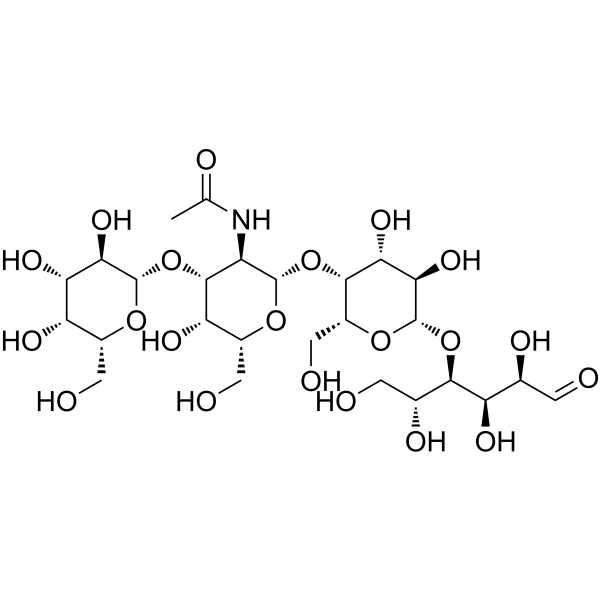| Description |
Gangliotetraose (Gg4) is a tetrasccharide, exhibits major components including GM1 and its sialylated derivatives. GM1 facilitates efflux of nuclear Ca2+ and reduces the level of nuclear Ca2+ that characterizes the differentiated neuron. GM1 affects neuronal plasticity and repair mechanisms, as well as neurotrophin release in the brain[1][2].
|
| Related Catalog |
|
| Target |
Akt, ERK1/2[3]; amyloid β-protein[4]
|
| In Vitro |
Gangliotetraose (GM1) (10 μM; 1 h) increases the viability of pheochromocytoma PC12 cells exposed to hydrogen peroxide (1 mM; 2 h) and diminishes the accumulation of reactive oxygen species and oxidative inactivation of Na+, K+-ATPase[3]. Gangliotetraose (GM1) (100 nM and 10 μM; ) increases the basal activity of Akt and ERK1/2, without changing Akt activity in PC12 cells exposed to hydrogen peroxide[3]. Gangliotetraose (GM1) (50 μM; 24 h) binds the midportion of Aβ to produce Aβ oligomers, GM1 bound Aβ (GAβ). GAβ is endogenously generated in the brain and accelerates Aβ assembly by acting as a seed[4]. Cell Viability Assay[3] Cell Line: Rat pheochromocytoma PC12 cells Concentration: 1 nM, 10 nM, 100 nM, 1 μM, 10 μM, 50 μM Incubation Time: 1 hour (preincubation); started 24 h after the transfer of the cells to the plates; exposed to 1 mM H2O2 for 2 h later Result: Showed protective effect (rescue rates, %) on PC12 cells exposed to H2O2 in a dose-dependent manner. The rescue rates ranged from 2.7% to 76% with concentration of 1 nM-50 μM.
|
| In Vivo |
Gangliotetraose (GM1) (30 mg/kg; i.p.; 5, 11, 42, and 73 d) stimulates the regeneration of nigrostriatal dopaminergic neurons in the central nervous system of rats after unilateral hemitransection[5]. Animal Model: Unilateral semi-transection model in Sprague-Dawley rats (170-190 g)[5] Dosage: 5 mg/kg; 30 mg/kg Administration: Intraperitoneal injection; 5, 11, 42, 73 days; started on day 2 after surgery and finished 24 h before sacrifice Result: Increased the Vmax of tyrosine hydroxylase (TH) in the lesioned side starting on day 14 dose-dependently with 73% (5 mg/kg/d) and 85% (30 mg/kg/d) of that of the unlesioned side, respectively.
|
| References |
[1]. Okada H, et al. Complement-mediated cytolysis and azidothymidine are synergistic in HIV-1 suppression. Int Immunol. 1998 Jan;10(1):91-5. [2]. Ledeen RW, et al. The role of GM1 and other gangliosides in neuronal differentiation. Overview and new finding. Ann N Y Acad Sci. 1998 Jun 19;845:161-75. [3]. Zakharova IO, et al. GM1 ganglioside activates ERK1/2 and Akt downstream of Trk tyrosine kinase and protects PC12 cells against hydrogen peroxide toxicity. Neurochem Res. 2014 Nov;39(11):2262-75. [4]. Toffano G, et al. GM1 ganglioside stimulates the regeneration of dopaminergic neurons in the central nervous system. Brain Res. 1983 Feb 14;261(1):163-6.
|
